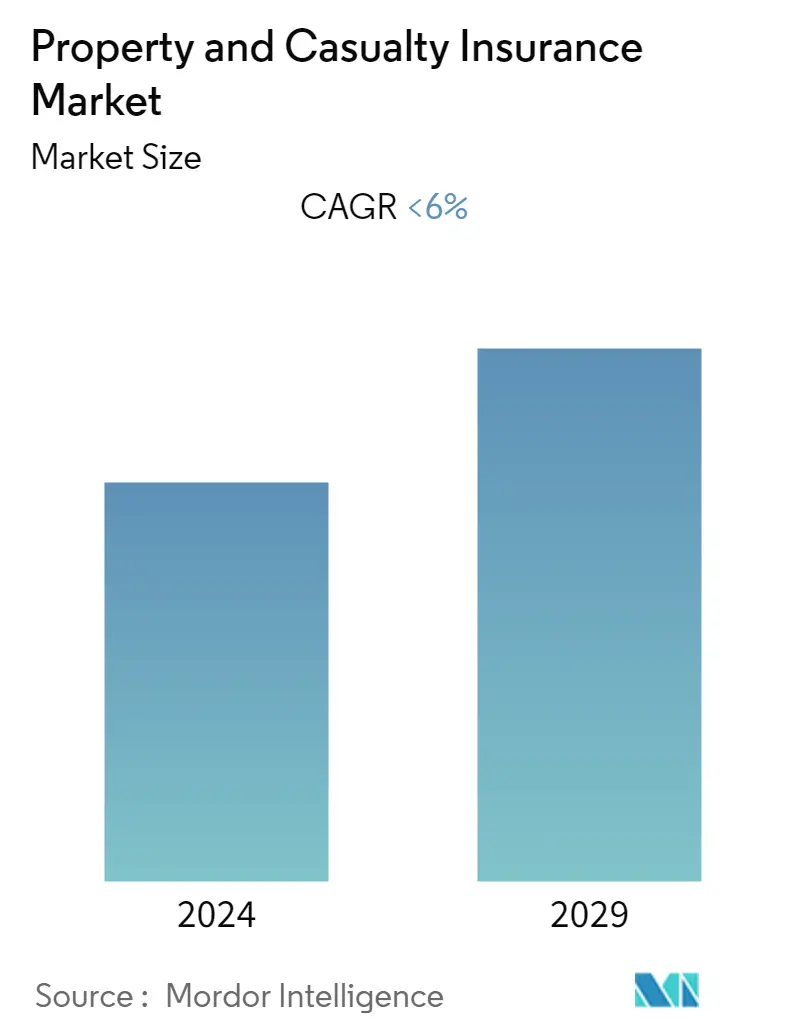Market Size of Property and Casualty Insurance Industry

| Study Period | 2020 - 2029 |
| Base Year For Estimation | 2023 |
| Forecast Data Period | 2024 - 2029 |
| Historical Data Period | 2020 - 2022 |
| CAGR | 6.00 % |
| Market Concentration | Low |
Major Players
*Disclaimer: Major Players sorted in no particular order |
US Property and Casualty Insurance Market Analysis
- The Property and casualty insurance market in the USA is estimated to grow at a CAGR of approximately 6% during the forecast period.
- Nine-months of 2019 delivered solid underwriting gains and brought the industry surplus to a new record. Net written premium growth seems small when compared against the unusually high nine-months 2018 level, but the two-year average growth rate is the strongest in years. The U.S. property and casualty insurance industry saw its net underwriting gains increase to USD 5.4 billion in the first nine months of 2019 from USD 4.7 billion a year earlier. The industry’s surplus grew in every quarter of 2019 so far, reaching a new all-time-high value of USD 812.2 billion as of September 30, 2019, after USD 802.2 billion as of June 30, 2019, and USD 742.1 billion as of December 31, 2018.
- In the first nine months of 2019, earned premiums grew 4.7% to USD 463.2 billion, while LLAE (Losses and loss adjustment expenses) grew 5.5% to USD 327.1 billion; other underwriting expenses grew 2.3% to USD 129.2 billion, and policyholders’ dividends increased to USD 1.6 billion from USD 1.5 billion a year earlier. As a result, the industry reported a USD 5.4 billion net underwriting gain, up from the USD 4.7 billion net underwriting gain for nine-months 2018.
- Net written premiums rose USD 12.8 billion to USD 481.3 billion in nine-months 2019 from USD 468.4 billion in nine-months 2018. Net written premium growth slowed to 2.7% from 11.4% for nine-months 2018. Net earned premium growth was 4.7% in nine-months 2019, slowing from 9.3% for nine-months 2018.
US Property and Casualty Insurance Industry Segmentation
This report aims to provide a detailed analysis of the Property and casualty insurance market in the United States. It focuses on the market dynamics, emerging trends in the segments and regional markets, and insights on various insurance and distribution channel types. Also, it analyses the key players and the competitive landscape in the Property and casualty insurance market in the United States.
| By Insurance Type | |
| Home | |
| Motor | |
| Others |
| By Channel of Distribution | |
| Direct | |
| Agency | |
| Banks | |
| Others |
Property and Casualty Insurance Market Size Summary
The U.S. property and casualty insurance industry is poised for growth, driven by a robust compound annual growth rate over the forecast period. The industry has demonstrated resilience with solid underwriting gains and a record surplus, indicating a strong financial position. Despite a slowdown in net written premium growth compared to previous years, the two-year average growth rate remains the strongest in recent times. The sector has benefited from advancements in technology, such as Robotic Process Automation, which enhances operational efficiency by streamlining tasks like claims processing and policy management. This technological integration is expected to further bolster the industry's growth trajectory.
The market landscape is characterized by fragmentation, with major players like Berkshire Hathaway, American International Group, and Liberty Mutual Holding Company leading the charge. However, the industry faces challenges such as soft insurance rates and low-interest rates, which have impacted revenue and profitability. These conditions may drive consolidation among larger insurers as they seek to capitalize on economies of scale and mitigate the effects of diminished organic growth opportunities. Despite these challenges, the property and casualty insurance sector remains a vital component of the U.S. financial system, with a promising outlook for continued expansion.
Property and Casualty Insurance Market Size - Table of Contents
-
1. MARKET DYNAMICS
-
1.1 Market Overview
-
1.2 Market Drivers
-
1.3 Market Restraints
-
1.4 Porters 5 Force Analysis
-
1.4.1 Threat of New Entrants
-
1.4.2 Bargaining Power of Buyers/Consumers
-
1.4.3 Bargaining Power of Suppliers
-
1.4.4 Threat of Substitute Products
-
1.4.5 Intensity of Competitive Rivalry
-
-
-
2. MARKET SEGMENTATION
-
2.1 By Insurance Type
-
2.1.1 Home
-
2.1.2 Motor
-
2.1.3 Others
-
-
2.2 By Channel of Distribution
-
2.2.1 Direct
-
2.2.2 Agency
-
2.2.3 Banks
-
2.2.4 Others
-
-
Property and Casualty Insurance Market Size FAQs
What is the current Property and Casualty Insurance Market size?
The Property and Casualty Insurance Market is projected to register a CAGR of less than 6% during the forecast period (2024-2029)
Who are the key players in Property and Casualty Insurance Market?
Berkshire Hathaway Inc., American International Group, Inc., Liberty Mutual Holding Company Inc., The Progressive Corporation and The Travelers Companies Inc are the major companies operating in the Property and Casualty Insurance Market.

